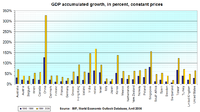
Photo from wikipedia
This paper analyzes the evolution and influence of gross domestic product per capita, labor force participation rate, gross fixed capital formation, and personal remittances on economic growth for European Union… Click to show full abstract
This paper analyzes the evolution and influence of gross domestic product per capita, labor force participation rate, gross fixed capital formation, and personal remittances on economic growth for European Union (EU) countries, using data from the World Bank (1996–2019) and from Eurostat (the first two quarters 2019–2020). The study has three components: statistical analysis, analysis of the evolution for each country and EU, and estimation of the impact on economic growth rate by using a linear multifactorial regression model for 1996–2019, 1996–2008, and 2009–2019. The model was validated by econometric techniques. The long-term causal relationship between exogenous and endogenous variables was validated by the Granger test. The results of the study show a differentiated evolution of the indicators, and that all indicators are severely affected by the 2008 financial crisis and the debut of the COVID-19 crisis in early 2020. The model used shows the significant positive influence of labor and investment, and the minor effect of remittances on economic growth. In the context of the COVID-19 epidemic, the results of the study could be arguments to be considered for the redesign of economic policies at European Union level.
Journal Title: Sustainability
Year Published: 2020
Link to full text (if available)
Share on Social Media: Sign Up to like & get
recommendations!